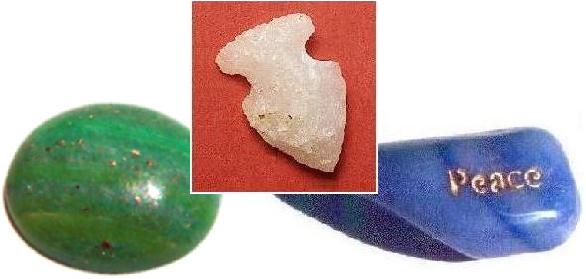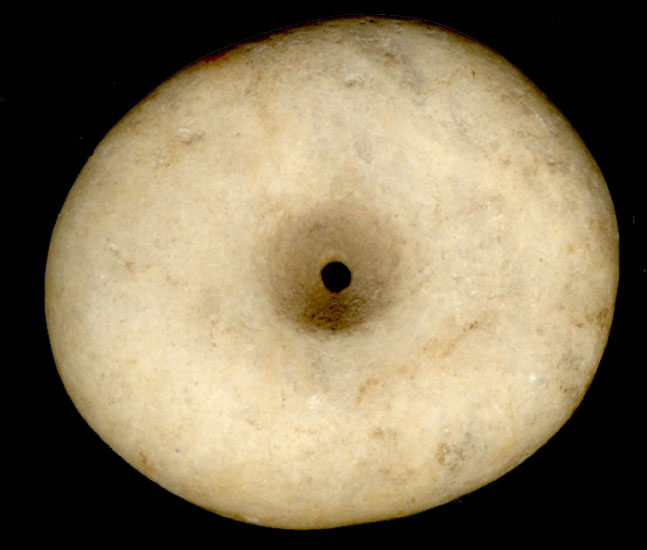( Fr- quartzite; Ger- Quartzit/Quarzfels;
Nor- kvartsitt; Rus- ![]() )
)
QUARTZITE

A. Quartzite. Native American arrow head (length ~ 3 cm) collected in Michigan. (© photo by D.L. Brittain)
B. Quartzite. "Greenlandite" cabochon (longer axis - 2.2 cm) from Godthåbsfjord area, southwestern Greenland. (© photo by Mark Cole, www.minershop.com)
C. Quartzite (dyed blue) paper weight
(longest dimension - 5 cm). R.D. Titamgim collection. (© photo
by Dick Dietrich)
D. Quartzite. Primitive quartzite disk money of West Africa -- see photograph, full caption and related text under REMARKS subheading.
DESCRIPTION: Quartzites consist of
sand grains with intergranular silica (i.e.,
quartz) cement. Although the term quartzite is widely used
as the name for metamorphosed sandstones, some geologists sometimes call silica-cemented
sandstones either sedimentary quartzites or orthoquartzites, and
distinguish them from metamorphosed sandstones by using the terms
metamorphic quartzites or metaquartzites.
Whatever, both have
been used as gemrocks.
Colors - white, smoky gray, rose-pink,
yellowish, green, blue, mauve, nearly black -- with the color dependent
upon
the pigmentation material, which commonly is only discernible
microscopically.
H. 7
S.G. ~ 2.7
Light transmission - transparent to
opaque
Luster - waxy
to vitreous
Breakage -
those with silica cement typically have imperfect to good conchoidal
fracture; that described as imperfect typically exhibits
granular
surfaces; the fracture of most quartzites that do not exhibit
conchoidal fracture is best described as irregular.
OTHER NAMES: Much quartzite occurs as the bedrock that "holds up" resistant ridges and hills. Distinct quartzite units are given stratigraphic unit names (see Appendix B, Glossary). -- Two examples are the Erwin Quartzite of the western Blue Ridge Province of eastern Tennessee, western North Carolina and southwestern Virginia; and the Flathead Quartzite of western Montana and adjoining Idaho and Wyoming.
Informal, nongeologic names have been used in the marketplace for some quartzites used as a gemrock. A few examples follow:
USES: Perhaps the greatest use of quartzite as a gemrock is as a substitute for jade: "Indian jade," which is green, has been shown to be quartzite with fuchsite inclusions (Webster, 1949), rather than aventurine quartz, as frequently reported; dyed quartzite has been used as a simulate for both purple and pink jade.
Aventurine, especially green aventurine, has a long history of use as beads (both spheres and carved) and cabochons; blue aventurine has become a favorite of lapidaries more recently. Greenlandite has been fashioned into all sorts of things such as carved signet rings, bookends, and candle holders, and has been included in mosaics and intarsias.
Quartzite -- usually dyed to some
pleasing color -- has been tumbled or otherwise fashioned into
decorative items such as the illustrated paperweight (Figure C).
Other uses include statuary, including small
busts etc.; carvings, including those for jewelry; and the
widespread fashioning and marketing of replicas of so-called indian
relics, especially arrow heads, that are used for all sorts of
decorations both for adornment and display.
NOTEWORTHY LOCALITIES: Reddish - near Almeria, Sierra de Gador, Spain; green - Hassan District of the state of Mysore, India; “greenlandite” - Godthåbsfjord area, southwestern Greenland.
REMARKS: Several versions of
etymology for the word quartz, the chief component of quartzites and
the fundamental part of its designation, are
recorded in the literature. In lieu of giving a summary of the
versions in, for example, the Oxford English Dictionary,
Webster's unabridged dictionaries and Mitchell (1979), it seems
appropriate to repeat the following, given by good
friend Clifford Frondel (1907-2002)
in his classic "...Silica Minerals"(1962):
"The name quartz, first used in the Middle Ages in Saxony for massive
vein quartz, did not become an inclusive designation for the colored
and fine-grained varieties of this mineral until about the end of the
eighteenth century."

SIMULANT:
***Snow quartz - white, "matte-finished tumbled pieces [of bubble-bearing silica glass] . . . produced by 'fusing quartz' and then rapidly cooling it" is described as a so-to-speak man-made quartzite by Johnson and Koivula (1999). - [Hardness of glass is only 5-5½ as compared to 7 for quartz, the main constituent of quartzite.]
REFERENCES: No general reference.
R. V. Dietrich © 2015
Last
update:
7 July 2013
web page created by Emmett Mason